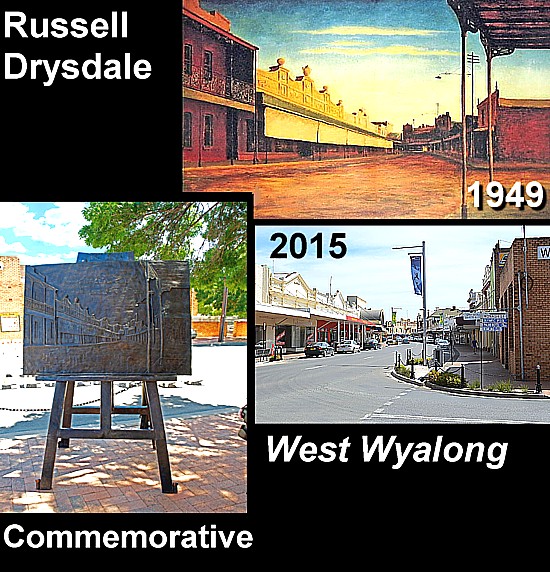 |
Copyright, Jim Lane
Coal Run Fork, 1974, Jim Lane |
I've always had a liking for street scenes. Over the years I've probably painted more than a dozen of them. Some I've painted simply to capture the present for the future as in my 1974 Coal Run Fork (above), near where we lived at the time (our mobile home was just to the right of this scene). In other cases I've simply been tempted by the challenge to do it and get it right. Single-point linear perspective has always fascinated me. At other times I've painted famous streets; and once, I painted a 360-degree panorama of a town square where four streets merged where I stood (bottom). Someday it should be quite valuable as something of an oddity, once my son (and only heir) sells it for less than I've been asking for it. Street scenes are popular with the local buying crowd. Unfortunately, paying for the long hours of work in each one, isn't. The Australian painter, Russell Drysdale apparently shares my affection for such art. He's painted as many or more than I have.
 |
| West Wyalong (upper-right), 1949, Russell Drysdale |
Some consider Russell Drysdale Australia's "most important" painter (whatever that means). I suppose it has to do with the number and importance of other artists he has influence, or, more likely, the manner he has captured the people and the desolation of his country's "outback" in his trademark surrealist manner. Drysdale's 1949 West Wyalong (above) is, therefore considered the country's "most important" painting. They've even planted on the street corner in West Wyalong from where it was painted, a monument to the painting (above, lower-left). I've also included a photo of the town as it looks today taken from the same spot.
 |
Sofala, 1947, Russell Drysdale. The large brick
building on the right can be seen in both images. |
In the 1947 painting,
Sofala (above), we can see more easily the changes seventy years have made in the scene. However, fond as he was of street scenes, they make up only a small portion of Drysdale's lifetime work. For example, if we were to compare Drysdale to other "important" artists from other nations, we'd have to say he's something of a combination of Grant Wood, Edward Hopper, Salvador Dali, with a little of Thomas Hart Benton and film maker, Tim Burton added for seasoning. That might seem like an odd combination but, quite frankly, Russell Drysdale was an odd artist.
 |
| The man, the artist, and his art. |
Russell Drysdale was born in 1912, at Bognor Regis, (a south coast resort community) in Sussex, England. His family moved to Australia, in 1923 where the young boy attended Geelong Grammar School in Victoria. He (or more likely, his family) intended to take up farming but as a teenager he developed a strong interest in art. In 1935 he began studying painting in Melbourne, continuing at the Grosvenor School in London, and La Grande Chaumière in Paris during the years leading up to 1939. Though still in his mid-twenties, upon returning to Australia, he garnered the "important" label. Yet he had not settle on either a personal style or content area.
 |
| Sunday Evening, 1941, Russell Drysdale |
 |
Rocky McCormick,
1962, Russell Drysdale |
In returning to Melbourne, Drysdale found a strong resistance to any acceptance of newer, European art forms. He decided to move to Sydney, where he saw the art world awakening to outside influences. There he immediately found success. Painted shortly after he settled in Sydney,
Sunday Evening (above) is one of Drysdale's earliest works depicting outback themes. It reveals the emergence of a style and approach to subject matter that signaled a radical break from his previous experiments as a student. In 1941 he traveled through the remoter sections of the hinterland. The
Back Ver-andah (below) probably dates from this period. Drysdale was famous all his life for his portraits of native Australians as seen in his
Rocky McCormick (right) dating from around 1962. His life's work contains dozens of portraits similar to this this one.
 |
| The Back Verandah, Russell Drysdale |
Drysdale's reputation continued to grow throughout the 1950s and 1960s as he explored remote Australia and depicted its inhabitants. In 1954, together with Sydney Nolan and William Dobell, he was chosen to represent Australia at the Venice Biennale. Drysdale married twice, and had a son, Tim, and a daughter, Lynne. Tim committed suicide in 1962 at the age of twenty one. The following year, Drysdale's wife, Bon, also killed herself. In 1964 Drysdale married Maisie Purves Smith, an old friend. In later years Drysdale was often accused of painting the same picture over and over again. He countered by saying that he was no different to a Renaissance artist, striving again and again to paint the perfect Madonna-and-Child. In 1969, Drysdale was knighted for his services to art. His later years saw a marked decrease in the quantity of his output, which had never been large to begin with. Drysdale died in Sydney in June, 1981.
 |
Copyright, Jim Lane
McConnelsville, Ohio, Town Square, 2001, Jim Lane |
 |
The Bath, 1941, Russell Drysdale.
Bathroom art was relatively rare at the time. |









No comments:
Post a Comment